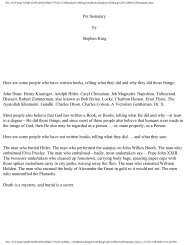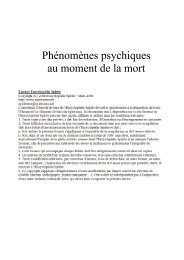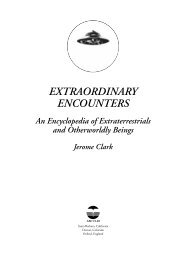You also want an ePaper? Increase the reach of your titles
YUMPU automatically turns print PDFs into web optimized ePapers that Google loves.
72 PASSPORT TO MAGONIA THE SECRET COMMONWEALTH 73<br />
... in which little men of dwarfish, and even pigmy, size, figure as<br />
good bowmen, slaying men of large size, and powerful make, by their<br />
dexterity in the use of the bow and arrow. 20<br />
In spite of their small size, they are understood to have been<br />
of very considerable strength. They were not "undersized in the<br />
same way that children arc, but full-grown individuals, undersized<br />
and sinew}', or muscular."<br />
These dwarfs or pygmies are called Na Amhuisgean or, more<br />
correctly, Na h-Amhuisgean. The English phonetics for the<br />
Gaelic "amhuisg" would be "awisk." The same beings are sometimes<br />
found under the names Tamhasg and Amhuish, and these<br />
words uniformly designate dwarfs. It is ironic, therefore, that in<br />
one talc (''The Lad with the Skin Garments," quoted by Mac-<br />
Dougall) the awisks address a human intruder as "O little man"<br />
while he in turn calls them "big men all."<br />
Now one point must absolutely be cleared up. Were there or<br />
were there not races of dwarfs living among the West and Middle<br />
Europeans of antiquity? Were the legends about the fairies and<br />
the elves based on the fact that the ancient inhabitants of the<br />
northern parts of the British Isles were such a race? Historical<br />
and archaeological researchers definitely say no, and we must<br />
agree with them. Yet several writers, such as David MacRitchic,<br />
claim there arc indications in this direction, and of course such<br />
indications would be crucial to any theory concerning the nature<br />
of the humanoids." 1<br />
In a book published in London in 1894, Tyson's Essay Concerning<br />
the Pygmies of the Ancients, Professor Windle, of Birmingham,<br />
remarks that a race of dwarfs supplied the "best warriors"<br />
and bodyguard of several kings. Tyson made an extensive study<br />
of the dwarf races and quotes the Greek historian Ctesias:<br />
Middle India has black men, who are called Pygmies, using the<br />
same language as the other Indians. ... Of these Pygmies, the king<br />
of the Indians has three thousand in his train; for they are very<br />
skillful archers.<br />
And he adds:<br />
There seem to have been near lake Zerrah, in Persia, Negrito [pygmy<br />
black] tribes who are probably aboriginal, and may have formed the<br />
historic black guard of the ancient kings of Susania.<br />
Tyson's work, to which Windle provided the Preface, was written<br />
in the seventeenth century. After calling attention to the remark<br />
by Ctesias, it goes on:<br />
Talentonius and Bartholine think that what Ctesias relates of the<br />
Pygmies, as their being very good archers, very well illustrates this<br />
Text of Ezekiel.<br />
The Ezekiel text in question appears thus in the King James Bible:<br />
The men of Arvad with thine army were upon thy walls round about,<br />
and the Gammadims were in thy towers. 22<br />
The Genevan translation printed in Edinburgh in 1579 also<br />
has "Gammadims" glossed "valorous men." In the Vulgate, however,<br />
it runs thus:<br />
Filii Arvad cum Exercitu tuo supra Muros tuos per circuitum, et<br />
Pygmaei in Turribus tuis fuerunt.<br />
And indeed, the English Bishops' Bible of 1572 and 1575 does not<br />
have "Gammadims" but "Pygmenians." Without going into<br />
further detail, it is clear that the Gaelic story of a guard of dwarf<br />
warriors is not an isolated case.<br />
If we return now to David MacRitchic's quotation from the<br />
Flemish folklore journal Ons Volksleven, we can learn more:<br />
The Fenlanders [a race dwelling in our country prior to the Kelts]<br />
were little, but strong, dexterous, and good swimmers, they lived by<br />
hunting and fishing. Adam of Bremen in the eleventh century thus<br />
pictures their descendants or race: "They had large heads, flat faces,<br />
flat noses, and large mouths. They lived in caves of the rocks, which<br />
they quitted in the night-time for the purpose of committing sanguinary<br />
outrages." The Keltic people, and later those of German<br />
race, so tall and strong, could hardly look upon such little folk as<br />
human beings. They must have regarded them as strange, mysterious<br />
creatures. And when these negroes or Fenlanders had lived for a<br />
long enough time hidden, for fear of the new people, in their grottoes,<br />
especially when they at length fell into decay through poverty,<br />
or died out, they became changed in the imagination of the dreamy<br />
Germans into mysterious beings, a kind of ghosts or gods. 23





